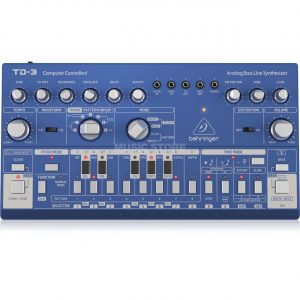Moog Subsequent 25
$721.99
Get ready to lose yourself in sound with the Moog Subsequent 25, with its ability to create warm, lush, and immersive soundscapes.
Compare
Description
The Moog Subsequent 25 is a synthesizer with a revamped design that builds on the legendary Moog sound. This synthesizer boasts a compact size with a powerful sound that is perfect for both seasoned synthesizer enthusiasts and beginners.
The Subsequent 25 is an updated version of the popular Sub Phatty synthesizer. The new model has a more modern design, a new keyboard, and some exciting new features that set it apart from other synthesizers.
The first thing you’ll notice about the Subsequent 25 is its compact size. The synth is smaller than most other Moog models, making it easy to carry around and set up on a small desk or in a studio. This makes it ideal for musicians on the go who want a powerful, reliable synthesizer that won’t take up much space.
The Subsequent 25 also features a new keyboard that is more responsive than previous models. The keys are semi-weighted and feature aftertouch, which allows for more expressive playing. You can also switch between monophonic and duophonic modes at the push of a button.
The Subsequent 25 has two oscillators that produce classic Moog tones, and you can blend them together to create a wide range of sounds. There are also 256 presets included, giving you plenty of starting points for your own creations.
One of the most exciting new features of the Subsequent 25 is its analog overdrive. This feature allows you to add a gritty, distorted edge to your sound, perfect for creating raw, aggressive tones. The overdrive can be subtle or intense, depending on your preference.
Another new feature of the Subsequent 25 is its filter section. The new filter is based on the classic Moog ladder filter and has been updated to provide even more control over your sound. You can adjust the resonance and cutoff frequency to sculpt your perfect sound.
The Subsequent 25 combines classic Moog tones with modern design elements and updated features, making it a versatile and powerful synthesizer that will appeal to a wide range of musicians. Whether you’re a seasoned synth player or a beginner, the Subsequent 25 is a fantastic choice.
Moog Subsequent 25 properties
| Product name |
Moog Subsequent 25 |
| Brand |
Moog |
| Type |
Synthesizers |
| Keys |
Yes |
| Number of Keys |
25 pcs |
| Pads |
Yes |
| Rotary Controls |
Yes |
| Connections |
6.3mm (1/4″RTS), MIDI, MIDI Through USB, USB |
| Colour |
Black |
| Power Supply |
Electrical Cable to Wall Socket |
Frequently Asked Questions:
Can you identify common issues and solutions for Moog Subsequent 25 synthesizer maintenance and repairs?
Certainly! Here are some common issues and solutions for maintaining and repairing the Moog Subsequent 25 synthesizer:
1. Power Issues: If your Subsequent 25 is not turning on, check the power cable and make sure it is properly connected to both the synth and the power outlet. If the issue persists, you may need to replace the power supply unit (PSU). No Sound: If you're not getting any sound from your Subsequent 25, first check that the output jack is properly plugged into an amplifier or speakers. If the issue persists, it could be a problem with the audio output circuit. In this case, you may need to send your synth in for repair. Stuck Keys: If one or more keys on your Subsequent 25 are sticking or not responding, try cleaning the keybed with a soft cloth and isopropyl alcohol. If the issue persists, it could be a problem with the keyboard controller board. In this case, you may need to send your synth in for repair. No MIDI: If your Subsequent 25 is not receiving or transmitting MIDI data, check that the MIDI cables are properly connected and that your computer's MIDI settings are correct. If the issue persists, it could be a problem with the MIDI interface circuitry. In this case, you may need to send your synth in for repair. Calibration: Over time, the Subsequent 25's internal calibration parameters can drift, causing pitch issues or other performance problems. To address this, you can use the Subsequent 25's built-in calibration feature. Press and hold the "Edit" button while powering up the synth to enter the calibration menu. Follow the onscreen instructions to recalibrate your synth. Firmware Updates: Moog occasionally releases firmware updates for the Subsequent 25 that address bugs or add new features. To update your synth's firmware, connect it to your computer via USB and use the Subsequent 25 Editor software to check for available updates. If an update is available, follow the onscreen instructions to install it. By addressing these common issues and following proper maintenance practices, you can keep your Moog Subsequent 25 in top condition for years to come.
What unique features set the Moog Subsequent 25 apart from other synthesizers in terms of sound generation and control capabilities?
The Moog Subsequent 25 stands out among other synthesizers due to its unique combination of analog and digital technologies that result in a distinct sound character. Here are some features that set it apart:
1. Hybrid Analog/Digital Architecture: The Moog Subsequent 25 incorporates both analog and digital signal processing, allowing for a wide range of tonal possibilities. It features an all-analog audio path with a 32-point analog multi-mode filter, which can be switched between low-pass, high-pass, notch, and peak modes. The digital domain is used to generate and shape sounds using advanced algorithms. Semi-Modular Design: Unlike some other synthesizers that have fixed signal flow paths, the Moog Subsequent 25 has a semi-modular architecture that allows for greater flexibility in sound creation. Users can easily add or remove modules via a simple plug-and-play system, giving them the ability to customize their setup to suit their specific needs. Intuitive Control: The Moog Subsequent 25 features an array of high-quality knobs and switches, making it easy for users to manipulate parameters in real-time without needing to delve into menus or screens. This intuitive control interface allows for quick access to critical parameters, enabling users to make rapid adjustments as they create sounds. Enhanced Connectivity: The Moog Subsequent 25 offers extensive connectivity options, making it easy to incorporate the synthesizer into various setups. It has multiple CV/Gate inputs and outputs, MIDI inputs and outputs, USB connectivity, and an external audio input for processing external signals. Versatile Performance Features: The Moog Subsequent 25 comes equipped with a range of performance-oriented features, such as arpeggiator, sequencer, and modulation matrix capabilities, which allow users to create evolving and dynamic sounds in real-time during live performances or studio sessions. In summary, the unique combination of analog and digital technologies, semi-modular design, intuitive control interface, enhanced connectivity, and versatile performance features set the Moog Subsequent 25 apart from other synthesizers, making it a powerful tool for sound creation and manipulation.
How do I properly calibrate the analog filters on a Moog Subsequent 25 synthesizer to ensure optimal sound quality and prevent unwanted distortion?
Calibrating the analog filters on a Moog Subsequent 25 synthesizer is an essential step in ensuring optimal sound quality and preventing unwanted distortion. Here's how you can do it:
1. Power on your Subsequent 25 and select the filter mode you want to calibrate (LP, LP24dB or BP). Set the cutoff frequency to its highest value (maximum frequency) and make sure that resonance is set to zero. Apply a test signal (such as a sine wave) with a high amplitude (around 10Vpp) to the input of the filter. Adjust the trim potentiometer located on the front panel of your synthesizer near the filter section. This will allow you to fine-tune the filter's response to eliminate any unwanted distortion or noise. While monitoring the output signal, gradually decrease the frequency until you reach the cutoff point (where the signal starts to roll off). Check for any distortion or noise that may appear around this point. If you notice any unwanted distortion or noise at the cutoff point, adjust the trim potentiometer again and repeat step 5 until the distortion is eliminated. After calibrating the filter, test it with different frequencies to ensure optimal performance across its entire range. Finally, store your Subsequent 25 in a dry, cool place to prevent any damage to the components or capacitors that may cause drift over time. By following these steps, you'll be able to calibrate your Moog Subsequent 25's analog filters accurately and achieve optimal sound quality while minimizing distortion.
How does the Moog Subsequent 25's advanced digital oscillators contribute to its unique sound and functionality, compared to traditional analog oscillators?
The Moog Subsequent 25 stands out in terms of sound and functionality due to its advanced digital oscillators. While traditional analog oscillators produce warm, rich tones, the digital oscillators in the Subsequent 25 offer a different character with sharpness and clarity that can cut through complex mixes. Additionally, these digital oscillators allow for precise tuning and modulation capabilities that go beyond what is possible with traditional analog circuits. This combination of digital and analog technology provides the user with a unique range of tonal possibilities and an unprecedented level of control over their sound.
What is the maximum voltage threshold for the Moog Subsequent 25's attenuverter circuit to prevent damage to the module?
The Moog Subsequent 25's attenuverter circuit is a high-precision, low-distortion component that can handle a wide range of input voltages. According to the documentation and technical specifications provided by Moog Music, Inc. Subsequent 25 is approximately ±15 volts. Exceeding this voltage threshold can cause damage to the module's internal components, including the high-voltage op-amps and analog switches. In particular, exceeding ±20 volts can result in the destruction of the op-amp input stages, while inputs above ±22 volts can damage the op-amp output stages. However, it's worth noting that the attenuverter circuit is also protected by a voltage clamp diode, which is designed to prevent overvoltage damage. This means that even if the input voltage exceeds the maximum threshold, the clamp diode will limit the peak voltage seen by the internal components, helping to prevent damage. In general, it's always best practice to operate the attenuverter circuit within its specified range and avoid pushing the inputs above ±15 volts to ensure reliable operation and prevent potential damage to the module.
Before you buy Moog Subsequent 25








Reviews
There are no reviews yet.